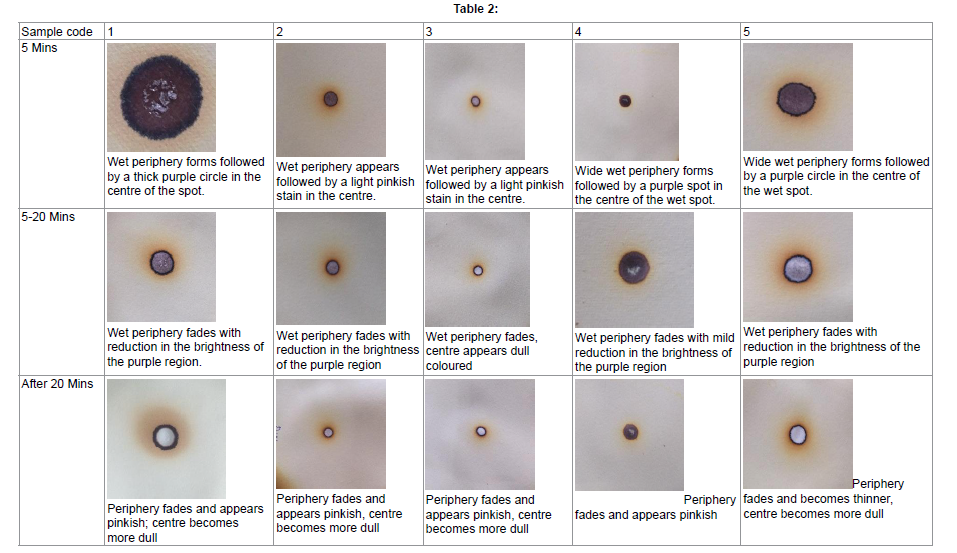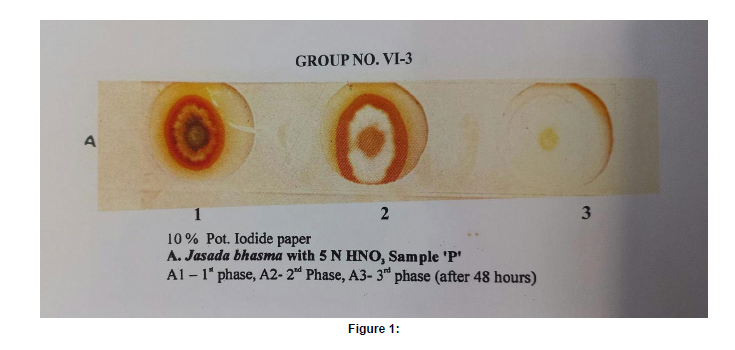Qualitative Analysis of Yashada Bhasma
Received: 03-Aug-2022 / Manuscript No. jabt-22-75519 / Editor assigned: 05-Aug-2022 / PreQC No. jabt-22-75519(PQ) / Reviewed: 19-Aug-2022 / QC No. jabt-22-75519 / Revised: 23-Aug-2022 / Manuscript No. jabt-22-75519(R) / Published Date: 30-Aug-2022
Abstract
Yashada-Bhasma is the calyx obtained by processing raw Yashada (Zinc). Its medicinal properties have been well identified centuries ago and have been used for the benefit of mankind. Even today, Yashada-Bhasma stands as a promising medicine for several ailments and is being manufactured by several pharmaceutical companies. In order to bring about standardized quality assessment of such a widely used medicine, an effort has been made to analyze five market samples of Yashada-Bhasma through traditional methods of Bhasma-pareeksha and contemporary methods including Namburi Phased Spot Test (NPST). The study intends to stand helpful for similar analysis of Bhasmas to bring about a standardized method of qualitative assessment.
Keywords: Yashada; Yashada-Bhasma; Bhasma; NPST; Namburi Phased Spot Test; Bhasma Pareeksha
Keywords
Yashada; Yashada-Bhasma; Bhasma; NPST; Namburi Phased Spot Test; Bhasma Pareeksha
Ayurveda is an Indian traditional system of medicine with a history of about 5000 years. The branch “Rasashastra” deals with the study of various ores, minerals and metals used in therapeutics. Yashadabhasma is one such therapeutic substance. Yashada (Zinc) has been in use extensively in Ayurveda since antiquity. Therapeutic application is possible after subjecting it to certain procedures to convert heavy and toxic metals that are unsuitable for use into medicinally compatible forms of “Bhasma” (calyx). In therapeutics, Yashada-bhasma (Calyx of Zinc) has shown efficacy in the management of various diseases such as diabetes mellitus, anemia, neuromuscular disorders, male infertility, ulcers, depression, ophthalmic problems, and so forth [1].
In the present era, various Ayurveda pharmaceutical industries are preparing and marketing Yashada-bhasma and is being widely prescribed by practitioners. It is therefore the need of the hour to evaluate and assess its quality by adopting certain established quality control parameters. Bhasma pareeksha is the term used for the classical assessment of Bhasmas. However newer analytical methods are also considered by Ayurveda professionals to substantiate and validate the quality of these bhasmas. The Namburi Phased Spot Test (NPST), is one such test based on chemical reactions and spotting. This methodology is now being used in analyzing various Bhasma samples.
The Namburi Phased Spot Test (NPST) is a qualitative test for Ayurvedic formulations based on the principle of chromatography. When a drop of clear solution of a substance under examination (Bhasma or Sindura) is placed on specially prepared chemically reacting papers, a spot appears which manifests a series of colour and pattern changes. In chemistry, techniques involving spot tests or chromatography are widely used. NPST involves observations of the spot and its colour, at three successive phases spread over three different time intervals. It thus has the advantage of measuring the sensitivity of reactions at different time intervals. In other words, it constitutes a method to study or detect continual chemical reactions taking place gradually between two chemical substances on static media, every second or even every fraction of a second. This technique was developed and standardized by Dr. Namburi Hanumantha Rao in 1970. It has been accepted by CCRAS, New Delhi [2]. NPST helps in identifying various samples of Bhasmas. It depends upon the pattern of the spot which develops after specific chemical reactions. In the present study, an attempt has been made to collect and compare various market samples of Yashada- Bhasma by adopting classical and contemporary analytical procedures like NPST for quality assessment.
Materials and Methods
Procurement of Yashada-Bhasma
Five different market samples of Yashada-Bhasma were collected from GMP certified Ayurvedic pharmacies. All the samples were prepared using the reference of Rasatarangini.
Bhasma-Pariksha
All the procured market samples of Yashada (No. 1, 2, 3, 4 & 5) were subjected to relevant classical Bhasma-Parikshas including Rekhapurnatwa, Varitaratwa, Unamatwa, Nishchandratwa and Nirdhumatwa.
NPST
Namburi Phased Spot Test for Yashada-Bhasma metal Zinc all the five samples were subjected to NPST. The following methodology has been followed [3].
Requirements per sample:
• 0.2 g Bhasma (sample)
• 0.5 ml of 5 N HNO3
• Centrifuge tube
• Dropper
• Heating apparatus
• Whatman’s filter paper #1
Procedure
• 0.2 gm of bhasma was placed in a centrifuge tube.
• 0.5 ml of 5N HNO3 was then added to it drop by drop, and heated for one minute.
• The solution was kept in a stand for 50 hours, during which it was shaken occasionally.
• It was then allowed to settle to form a clear layer.
• One drop was taken from the clear layer and placed on 10% potassium iodide paper (prepared using Whatman’s filter paper no.1).
• Colour changes in the paper were observed over 3 phases i.e., after 5 minutes, after 5-20 minutes and after 20 minutes.
Results
The following were the observations made out of the five samples through observation and Bhasma-pareeksha mentioned in table no.1. (Table 1)
The following observations were noticed from the Namburi Phased Spot Test for the samples presented in table no.2. (Table 2)
Discussion
Our classics prescribe Yashada-bhasma to be Kundendudhavala, i.e., as white as a “Kunda” flower or the moon [4]. However, among the samples collected, we may observe that only two samples (1 and 3) are white. Sample 2 was mild grey. Sample 4 was dark grey and sample 5 had a sandal tint. This directly suggests that there are some variations in the quality of the five samples. Further, we find that sample 2 did not pass Rekhapurnatwa, Varitaratwa and Unamatwa. Sample 3 did not pass Varitaratwa, Unamatwa and Nishchandratwa. Sample 4 did not pass Nishchandratwa and sample 5 did not pass Nishchandratwa and Nirdhumatwa.
According to NPST standards, the following observations are to be expected from a genuine sample of Yashada-bhasma. (Figure 1) (Table 3).
Among the five samples selected, only sample 1 passed all of the Bhasmapareekshas. However, we find that none of the samples comply with the standards prescribed by NPST. Previous studies clarify that NPST standards are met when the process of Marana is carried out using Parada.2 However, the samples collected have been prepared following the reference of Rasatarangini, wherein Marana is carried out using Kumariswarasa as bhavana dravya, the same is adopted by API, wherein samanya-shodhana is first prescribed by Dhalana through Taila, takra, gomutra, aranala and kulatthakwatha, seven times each [5]. No visheshashodhana method is prescribed by API. Further, Jarana using Apamarga-churna and Marana by preparing Chakrikas by triturating Jarita-yashada with Kumari swarasa are advised. Though the samples were from five different market sources, the reference (method) used to prepare the samples have been the same. Our Acharyas have also stated that it is best to perform Marana with the help of Parada [6].
Strictly going by the guidelines of API, there is no vishesha-shodhana prescribed, and Marana is prescribed using Kumariswarasrasa. However, in samples that have followed the same, NPST standards have not been met. However, in previous studies where visheshashodhana was done following samanyashodhana and Marana was done using Parada rather than any herbs, NPST standards were met [7]. Thus, it may be concluded that.
Conclusion
The Yashadha bhasma samples collected from the market are fairly matching with the classical and NPST quality assessment parameters. All processes starting from selection of the raw material till Marana in the preparation of Yashadha bhasma play an important role in the final product. It must also be noted that NPST is a method that is sensitive to the superiority of Bhasmas and can accurately suggest the quality of a finished Bhasma.
References
- Umrani RD, Paknikar KM (2015) Jasada bhasma, a Zinc-Based Ayurvedic Preparation: Contemporary Evidence of Antidiabetic Activity Inspires Development of a Nanomedicine. Evid Based Complement Alternat Med 2015:193156.
- Bhojashettar S, Poornima BT, Jadar PG (2011) Evaluation of market samples of 'Yashada bhasma' using 'Namburi Phased Spot Test'. J Ayurveda Integr Med.2: 69-71.
- Namburi RH (2010) Application of Standardised Namburi Phased Spot Test in Identification of Bhasma and Sindura Preparations of Ayurveda, CCRAS 2010: 76.
- Angadi R (2014) A textbook of Rasasastra, Chaukhamba Surbharati Prakashan, 2014: 405.
- The Ayurvedic Pharmacopoeia of India (2003) Part I, Second edition, GOI, MoHFW 18: 618-621.
- Satpute AD (2014) Rasaratnasamuchchaya (Chapters 1-11), Chaukhamba Sanskrit Pratishthan, 2014: 110.
- Namburi RH (2010) Application of Standardised Namburi Phased Spot Test in Identification of Bhasma and Sindura Preparations of Ayurveda, CCRAS 2010: 77.
Indexed at, Google Scholar, Crossref
Indexed at, Google Scholar, Crossref
Citation: Adarsh T, Dhwani J, Hiremath R (2022) Qualitative Analysis of Yashada Bhasma. J Anal Bioanal Tech 13: 475.
Copyright: © 2022 Adarsh T, et al. This is an open-access article distributed under the terms of the Creative Commons Attribution License, which permits unrestricted use, distribution, and reproduction in any medium, provided the original author and source are credited.
Share This Article
Open Access Journals
Article Usage
- Total views: 1564
- [From(publication date): 0-2022 - Apr 07, 2025]
- Breakdown by view type
- HTML page views: 1212
- PDF downloads: 352




